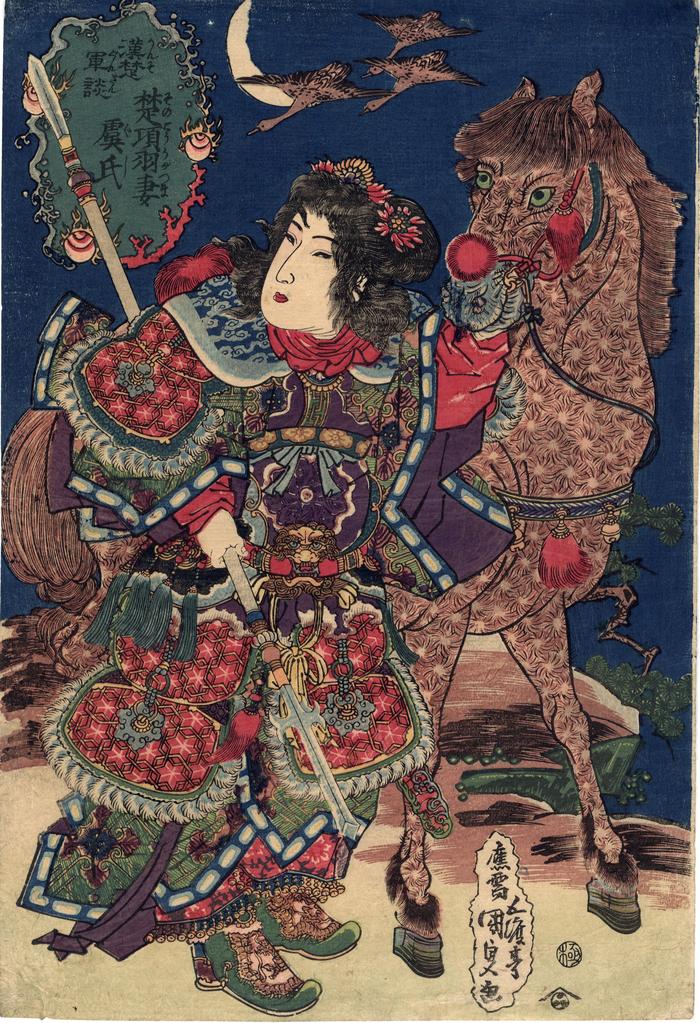Utagawa Kunisada (歌川国貞) / Toyokuni III (三代豊国) (artist 1786 – 01/12/1865)
Gushi /Yu Ki (楚項羽妻 虞氏) from the series Military Tales of the Han and Chu (Kan so gundan - 漢楚軍談)
ca 1827
10.25 in x 15 in (Overall dimensions) Japanese color woodblock print
Signed: ōju Gototei Kunisada ga
應需五渡亭国貞画
Publisher: Nishimuraya Yohachi
(Marks 391 - seal 01-008)
Censor's seal: kiwame
Lyon Collection - Fan Kuai print from this series
Ruth Chandler Williamson Gallery
Lyon Collection - Chōryō print from this series
Chazen Museum of Art
Ishikawa Prefectural Museum of Art James King and Yuriko Iwakiri in their Japanese Warrior Prints: 1646-1905 in writing about one sheet from this set on page 244 noted:
Kunisada's Military Tales of the Han and Chu may have been a relatively small series; to date six images have been recorded. In addition to the two prints reproduced here... they include Kōseikiko (Huang Shi Gong) with Chōryō (Zhang Liang), Han Kai (Fan Kuai), Kōu (Xiang Yu) and the female warrior Gushi (Yi Shi). the source of this series is most likely Xi Han yan-i Romance of the West Han; Japanese: Saikan engi, 15th c.) by Yang Wei, but Kunisada likely drew from the 1804 yomihon, Ehon Kanso gundan (Illustrated Military Tales of the Han and Chu), written by Takizawa Bakin and illustrated by Kitao Shigemasa.****
Sebastian Izzard in his Kunisada's World (p. 106) wrote about the theme of the set this print is from:
The series designed by Kunisada around the same time alludes to Chinese historical figures from the Qin and Han dynasties. The events surrounding the fall of the Qin dynasty (221-207 B.C.) and the rise of the Han dynasty (206/202 B.C.-A.D. 220) were a rich vein of source material for the many legends and stories of bravery, cowardice, love and betrayal that have come down from this period of Chinese history.****
Gushi is the wife of Kou, the 1st Han emperor (项羽: 232-202 B.C.). She is one of the "Four beautiful women of China". When Kou was beset by enemies he refused to leave his dire situation because of her. Gushi (Yu Ki) cut her own throat to relieve him of responsibility for her. He made off with her severed head on the pommel of his horse. [Most of this information is taken directly from kunisada.de.]
****
According to a note at kunisada.de there were two different publishers for this print: Nishimuraya Yohachi and Jōshūya Jūzō. Geoffrey Dun argued that the first printing was by Jōshūya Jūzō and Sebastian Izzard later agreed.
Nishimuraya Yohachi (西村屋与八) (publisher)
warrior prints (musha-e - 武者絵) (genre)
Historical - Social - Ephemera (genre)
kari (wild geese - 雁) (genre)
